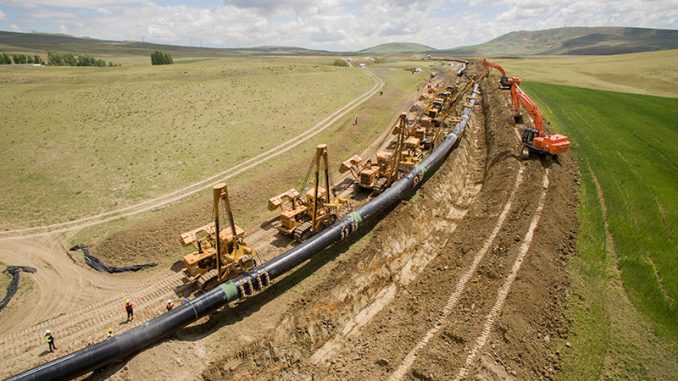A statement of the Hungarian Foreign Minister, after a high-level meeting in Romania, highlighting the exclusive interest to purchase gas from Romania, but through a pipeline built by Romanians, basically certifies the lack of interest in BRUA project. As Hungary is a country that over time has proven a high pragmatism and has pursued its national interest, I propose that we review the relationship between Romania and Hungary in the gas sector.
Natural gas discovered accidentally in Transylvania when it was a Hungarian territory was lifted to industrial level by the visionary intervention of Germany’s Deutsche Bank, which established the first company for the production, transmission, distribution and use of natural gas in Europe, in 1915. The company was owned by Deutsche Bank with a 45% stake, while 15% was owned by the Hungarian state and 40% by Hungarian and Austrian natural and legal persons. After the end of World War I, in accordance with the provisions of the Versailles Treaty, a company located on the territory acquired by Romania and whose capital belonged to the countries declared victorious in the World War I could be liquidated, its goods passing to the patrimony of the Romanian state. However, certain political circles in Romania have decided to first put under forced administration the gas company and only then liquidate the company. This position of Romanian politicians gave time to shareholders to fall back and obtain, 9 years after signing the Versailles Treaty, when a relaxation was obtained towards the countries declared to have lost the war, from the victorious countries a judgment of the Court in Paris stating that the gas company was not subject to the Versailles Treaty. Thus, Romania was forced to repurchase what rightfully belonged to it for an amount 4 times higher than its value at the actual takeover.
In 1940, the Vienna Award changed the border with Hungary, making the Tg. Mureş Distribution Division of the gas company, with all its assets and the transmission pipeline Seuca Tg. Mureş, for a section of 9km, operate on the Hungarian territory. This situation existed until 1944. The Tg. Mureş Distribution Division, belonging to the Romanian gas company, operated in this entire period the transmission pipeline and ensured gas supply to the city of Tg. Mureş, placed on the Hungarian territories according to the Vienna Award, from the Deleni field, which remained on Romania’s territory. In fact, during 1940-1944 Romania exported gas to Hungary, at prices imposed by it.
On 12 June 1952 a convention was signed between the Romanian and Hungarian governments, agreeing to supply gas to Hungary through a 10 inch pipeline built west to Satu Mare. Gas deliveries started on 1 October 1958. Thus, Hungary benefited for 23 gas from gas from Romania at an advantageous price.
An agreement was signed in 1998 to build an interconnection between Romania and Hungary, in order to import gas from the North Sea via Hungary. This agreement determined the construction of a pipeline from Arad to Horia on the Romanian side, which remained for 10 years nonoperational, due to the fact that the deal failed especially because of Hungary’s intention to ensure gas resale in Romania.
In 2010, Horia pipeline was extended to the Hungarian transmission system, achieving the interconnection between the transmission systems of Romania and Hungary, to allow gas imports from Hungary, but subsequently Hungary obtaining the possibility to import gas (today limited) from Romania.
In 2003, the GRANT AGREEMENT TEN-E/2003/57100/Z/03 was concluded with the European Community on the one side and OMV Erdgas GmbH on the other side, which represented the beneficiaries (MOL Hungary, BOTAS Turkey, Bulgargaz EAD, Transgaz Romania) and which laid the foundations of NABUCCO project. Hungary has chosen to play its national interest very well in this project, even risking some sanctions for its withdrawal from the project. It chose in 2012 to exit the first from Nabucco project, when it understood that this move would bring gains.
In September 2016, the Ministry of Economy signed with the EC the Funding Agreement through the Connecting Europe Facility, allocating EUR 179.32mln for the first phase of BRUA project. Then, the ministry informed that Transgaz could implement, by 2020, the first phase of the transmission corridor Bulgaria-Romania-Hungary-Austria, with a length of around 550km, on Giurgiu – Podişor – Corbu – Hurezani – Haţeg – Recaş – Horia corridor, and build three compressor stations, located on the pipeline route (Corbu CS, Haţeg CS, Horia CS).
Hungary played smart in this project as well, waiting until the tenders were almost over in Romania for BRUA ST1 and then changing its tune, showing that it was no longer interested in BRUA. In late July 2017, Transgaz informed, according to the press, that BRUA gas pipeline would no longer cross Hungary, the operator of the gas system in this country, FGSZ, proposing that the volume of gas coming from Romania be distributed from Hungary to Slovakia, Ukraine, Croatia or Serbia.
On 5 February 2018, the Foreign Minister of Hungary declared gladly that “it is the first opportunity in decades that Hungary has to buy large amounts of natural gas from a different source than Russia. The Romanian side agreed to build compressor stations allowing gas supply to Hungary as of 2020”. Thus, Hungary imposes again its supremacy, even only at a declarative level, as Romanian representatives in the gas market say.
We need to understand the intelligence, the professionalism and fortitude with which Hungarian politicians have managed to score for Hungary in the gas market and we congratulate them for wanting more than others.



Recent Comments